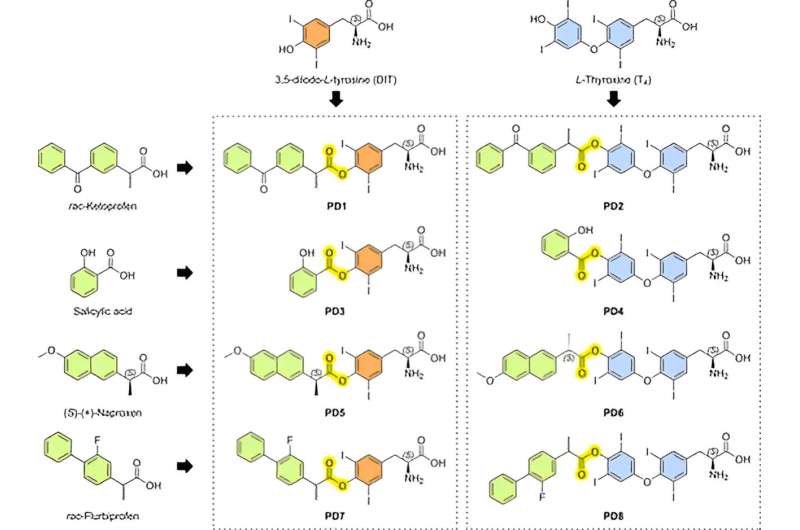This article has been reviewed according to Science X's editorial process and policies. Editors have highlighted the following attributes while ensuring the content's credibility:
fact-checked
peer-reviewed publication
trusted source
proofread
Study finds a thyroxine derivative enhances brain drug delivery

A new study from the University of Eastern Finland shows that the delivery of drugs into the brain, and especially into glial cells, can be enhanced with prodrugs that temporarily incorporate thyroxine or a thyroxine-like molecule. The transporter protein OATP1C1, which is found in the brain, can be utilized in the delivery of such prodrugs. The results were published in Journal of Medicinal Chemistry.
For the first time ever, researchers used the organic anion-transporting polypeptide 1C1 (OATP1C1) to enhance drug delivery into the brain.
In the study, prodrugs were used to transport anti-inflammatory drugs into the brain, where they were efficiently delivered into glial cells. Glial cells support neurons and are known to be activated in many brain diseases to produce mediators that maintain inflammation. Hence, in order to have an impact on chronic inflammation in the brain, it is crucial to deliver anti-inflammatory drugs into precisely the right cell types. The concept is completely new, even on a global scale.
Researchers at the University of Eastern Finland School of Pharmacy have long been attempting to enhance brain drug delivery by using the L-type amino acid transporter 1, i.e., the LAT1 protein and prodrugs that utilize it, amino acid derivatives. However, the OATP1C1 transporter protein used in the new study was found to be far more effective at transporting thyroxine derivatives than LAT1.
The study employed computational molecular modeling to create protein models that were used to design and synthesize new prodrugs.
Drug transport mechanisms remain surprisingly poorly understood
"A surprising observation from our study was that increasing the molecular size of drugs enhanced their delivery into the brain and into glial cells. Up until now, it has been thought that a large molecular size isn't exactly helpful in brain drug delivery," says Research Group Director, Associate Professor Kristiina Huttunen of the University of Eastern Finland.
"This study highlights how poorly we still understand drug transport mechanisms in our system. This is also a major reason why many new drugs, especially those intended to affect the central nervous system, unfortunately never make it to the market. The more we know about these transport mechanisms, the better we can take their effects into account when seeking to influence the distribution of drugs in our body. This should also be taken into account very early on in drug development."
More information: Arun Kumar Tonduru et al, Targeting Glial Cells by Organic Anion-Transporting Polypeptide 1C1 (OATP1C1)-Utilizing l-Thyroxine-Derived Prodrugs, Journal of Medicinal Chemistry (2023). DOI: 10.1021/acs.jmedchem.3c01026
Journal information: Journal of Medicinal Chemistry
Provided by University of Eastern Finland





















